World Tuberculosis Day (March 24th): Date, History, Celebration, Facts, and more
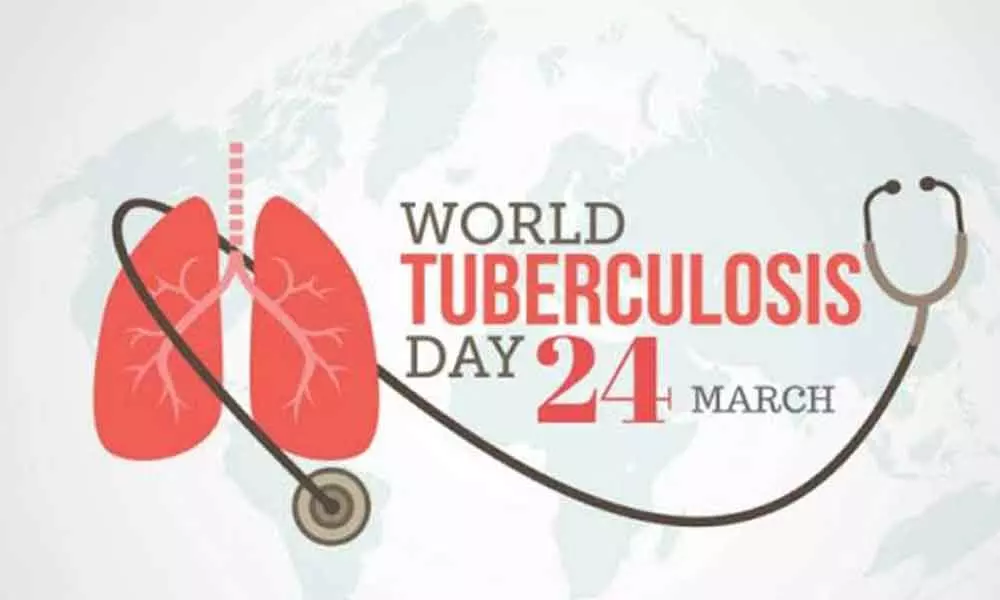 |
| World Tuberculosis Day - March 24 |
World Tuberculosis Day: Date
Each year, we commemorate World Tuberculosis (TB) Day on March 24 to raise public awareness about the devastating health, social and economic consequences of TB, and to step up efforts to end the global TB epidemic. The date marks the day in 1882 when Dr Robert Koch announced that he had discovered the bacterium that causes TB, which opened the way towards diagnosing and curing this disease.
TB remains one of the world’s deadliest infectious killers. Each day, nearly 4000 lose their lives to TB and close to 28,000 people fall ill with this preventable and curable disease. Global efforts to combat TB have saved an estimated 63 million lives since the year 2000.
What is Tuberculosis and how is it contracted?
Tuberculosis (TB) is caused by a bacterium called Mycobacterium tuberculosis. The bacteria usually attack the lungs, but TB bacteria can attack any part of the body such as the kidney, spine, and brain. Not everyone infected with TB bacteria becomes sick. As a result, two TB-related conditions exist: latent TB infection (LTBI) and TB disease. If not treated properly, TB disease can be fatal.
TB is spread when one person who is ill with pulmonary TB disease coughs bacteria into the air. The bacteria are then inhaled into the lungs of another person who becomes infected. Most who are infected do not become ill right away. Only about five to 15 percent of people who become infected with TB become ill in their lifetime. However, the risk of becoming ill can be much higher in people who have HIV, are very young, or have other risk factors such as diabetes. Those who smoke, consume alcohol, have poor nutrition or are taking medications that decrease their immune system also face higher risks.
Treating tuberculosis is challenging because the bacteria that cause it to divide much more slowly than most bacteria, taking around 15-20 hours to do so. As many antibiotics target bacterial cell division, this can make the TB bacteria take much longer to wipe out. In addition, the bacteria have a unique cell wall containing waxes formed from mycolic acids which render many antibiotics ineffective.
The World Health Organization has set an ambitious goal for the global community: to reduce TB deaths by 95 percent between 2015 and 2035 and to cut new cases by 90 percent during the same time period. In order for this to happen new drugs to tackle the disease will be crucial.
History and Significance of World Tuberculosis Day
 |
| Photo: Everyevery |
On March 24, 1882, Dr. Robert Koch announced the discovery of Mycobacterium tuberculosis, the bacteria that causes tuberculosis (TB). During this time, TB killed one out of every seven people living in the United States and Europe. Dr. Koch’s discovery was the most important step taken toward the control and elimination of this deadly disease. A century later, March 24 was designated World TB Day: a day to educate the public about the impact of TB around the world.
Until TB is eliminated, World TB Day won’t be a celebration. But it is a valuable opportunity to educate the public about the devastation caused by TB and how it can be stopped.
In 2018, as part of the “We Can Make History: End TB” World TB Day theme, CDC honored TB elimination leaders and history-makers through the TB Chronicles. The TB Chronicles depicted TB milestones that highlight both how far we have come and how far we must go towards ending TB.
Johann Schonlein coined the term “tuberculosis” in the 1834, though it is estimated that Mycobacterium tuberculosis may have been around as long as 3 million years!
Tuberculosis (TB) was called “phthisis” in ancient Greece, “tabes” in ancient Rome, and “schachepheth” in ancient Hebrew. In the 1700s, TB was called “the white plague” due to the paleness of the patients. TB was commonly called “consumption” in the 1800s even after Schonlein named it tuberculosis. During this time, TB was also called the “Captain of all these men of death.”
During the Middle Ages, TB of the neck and lymph nodes was called “scofula.” Scofula was believed to be a different disease from TB in the lungs.
Today, our names for TB tell us where TB is located (pulmonary, extrapulmonary) and how to treat it (drug-susceptible, drug-resistant, multidrug resistant, and extensively drug-resistant.)
CDC and many organizations around the world are working towards a future where we call TB “history.”
TB is not just a disease found in humans
TB is a disease that infects animals as well as humans. Archeologists have found TB in the bones of ancient bison in Wyoming. These bison lived over 17,000 years ago.
Mycobacterium bovis (Bovine TB) can still be found in many animals in the United States including cattle and deer. Approximately 1 million cattle are tested each year for TB. The cattle at most risk for TB are those that come into contact with wildlife that carry TB (like deer). It is possible for some animals to transmit TB to humans.
Finding TB is the first step towards ending TB
The TB skin test for TB infection measures a person’s immune response. The test is performed by injecting a small amount of fluid (called tuberculin) into the skin on the lower part of the arm. A health care worker “reads” the test 48-72 hours later.
The TB skin test was developed over time. In 1890, Robert Koch developed tuberculin (an extract of the TB bacilli) as a cure, though it proved to be ineffective. In 1907, Clemens von Pirquet developed a skin test that put a small amount of tuberculin under the skin and measured the body’s reaction. Pirquet also invented the term “latent TB infection” in 1909. In 1908, Charles Mantoux updated the skin test method by using a needle and syringe to inject the tuberculin.
In the 1930s, American Florence Seibert PhD developed a process to create a purified protein derivative of tuberculin (PPD) for the TB skin test. Prior to this, the tuberculin used in skin tests was not consistent or standardized. Seibert did not patent the technology, but the United States government adopted it in 1940.
The TB skin test is still used today and has remained virtually unchanged for almost eighty years. The test and PPD are still listed on the World Health Organization’s essential medicines list. A more recent advancement in TB testing has been TB blood tests, or interferon-gamma release assays (IGRAs).
Vaccine invented for TB
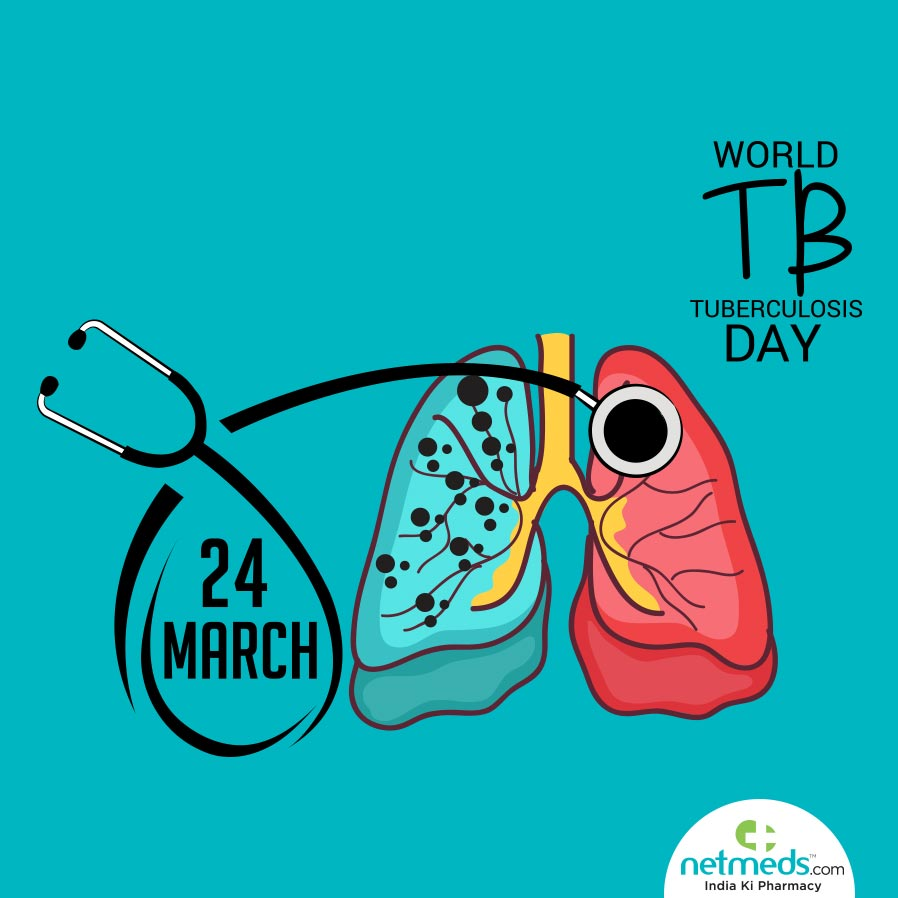 |
| Photo: Netmeds |
Albert Calmette and Jean-Marie Camille Guerin developed the Bacille Calmette-Guérin (BCG) vaccine in 1921. Prior to developing the BCG vaccine, Calmette developed the first antivenom to treat snake venom.
The BCG vaccine is not widely used in the United States, but it is often given to infants and small children to prevent TB meningitis in countries where TB is common. BCG does not always protect people from getting TB. TB blood tests are the preferred TB test for people who have received the BCG vaccine.
Vaccine research continues into the future. When a more effective TB vaccine is developed and deployed, it could reduce disease and death around the world.
Treatment remained largely unchanged until about 80 years ago
Until the discovery of antibiotics, treatment for TB was limited to warmth, rest, and good food… or “lana, letto, latte” in Italian.
In the Middle Ages, treatment for scofula (TB of the lymph nodes and neck) was the “royal touch.” People lined up for the royal touch of English and French kings and queens, hoping a touch from the sovereign would result in a cure.
Cod liver oil, vinegar massages, and inhaling hemlock or turpentine were all treatments for TB in the early 1800s.
Antibiotics were a major breakthrough in TB treatment. In 1943, Selman Waksman, Elizabeth Bugie, and Albert Schatz developed streptomycin. Waksman later received the 1952 Nobel Prize for Physiology and Medicine for this discovery.
Today, four drugs are used to treat TB disease: isoniazid (1951), pyrazinamide (1952), ethambutol (1961), and rifampin (1966). This 4-drug cocktail is still the most common treatment for drug-susceptible TB.
2021 Theme for World Tuberculosis Day
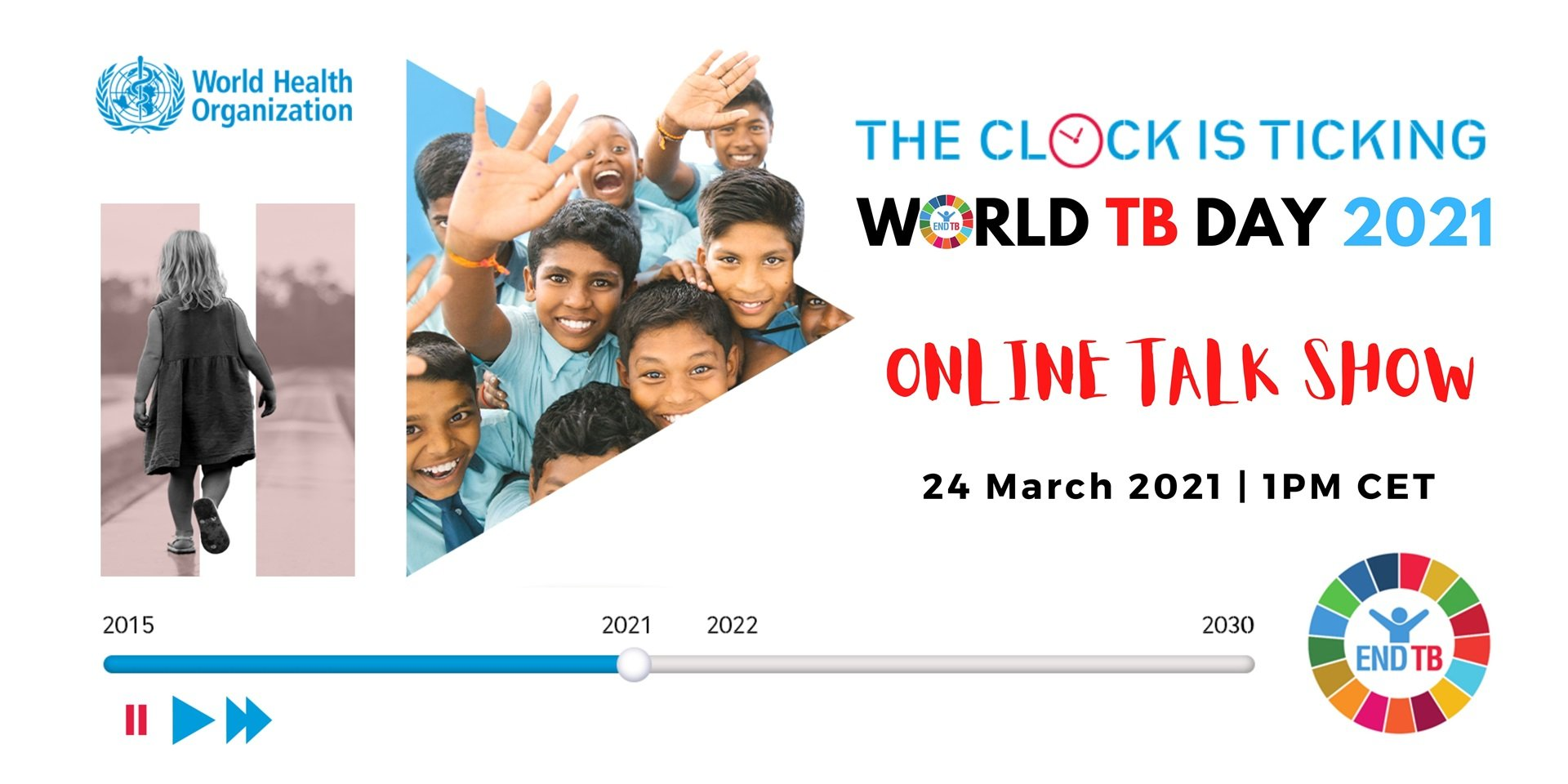 |
| Photo: WHO |
The theme of World TB Day 2021 - ‘The Clock is Ticking’ –conveys the sense that the world is running out of time to act on the commitments to end TB made by global leaders. This is especially critical in the context of the COVID-19 pandemic that has put End TB progress at risk, and to ensure equitable access to prevention and care in line with WHO’s drive towards achieving Universal Health Coverage.
With this theme, the Stop TB Partnership and all partners are sounding the alarm that while we focuse on COVID-19, every single day 4000 people die and 27 000 people get sick with TB.
How to observe and celebrate World Tuberculosis Day
Get tested
Disease prevention always starts with you. Testing for tuberculosis is simple, and is sometimes required for travel or job applications. It’s always a good thing to have on your medical records and not in your lungs.
Spread awareness
Many people with TB don’t even know they have it. Latent tuberculosis can lie dormant for years without a single symptom. This is why it’s important to spread awareness about how to get tested and treated. With any disease, prevention is the best cure.
Volunteer or donate
Events are held to spread awareness and raise funds all around the world on World Tuberculosis Day. If you can’t find one, organize one yourself. There are many organizations dedicated to the eradication of TB that are always looking for volunteers and donations.
Quick Facts on World Tuberculosis Day
Tuberculosis is curable and preventable but is still one of the top 10 causes of death worldwide.
Its symptoms include:
• Cough that lasts three or more weeks
• Coughing up blood
• Chest pain, or pain with breathing or coughing
• Unintentional weight loss
• Fatigue
• Fever
• Night sweats
• Chills
• Loss of appetite
GETTING TESTED FOR TB
About one quarter of the world's population has latent TB, meaning people have been infected by the bacteria but are not (yet) ill with the disease and cannot transmit the disease. You should get tested for TB if:
• You think you might have TB disease
• You’ve spent time with a person known or suspected to have TB
• You have HIV infection or a condition that suppresses your immunity and puts you at high risk
• You think you might have TB
• You’re from a country where TB is very common
• You inject drugs or live in areas where TB is known to be very common
TIPS ON PREVENTING TB
• Wash your hands after sneezing, coughing or holding your hands near your mouth or nose.
• Cover your mouth with a tissue when you cough, sneeze or laugh. Discard used tissues in a plastic bag, then seal and throw it away.
• Avoid close contact with TB patients.
• Sleep in a room far away from family members who have active TB .
• Ventilate your room regularly
• In countries where tuberculosis is more common, infants are often vaccinated with Bacilli Chalmette-Guerin (BCG) vaccine to prevent severe tuberculosis.
• Finish your entire course of medication – this is the most important step you can take to protect yourself and others from tuberculosis. When you stop treatment early or skip doses, TB bacteria have a chance to develop mutations that allow them to survive the most potent TB drugs. The resulting drug-resistant strains are much more deadly and difficult to treat.
***READ MORE: World Health Day: History, Significance, Celebration, Wishes and Quotes
World Tuberculosis Day: Messages and Quotes
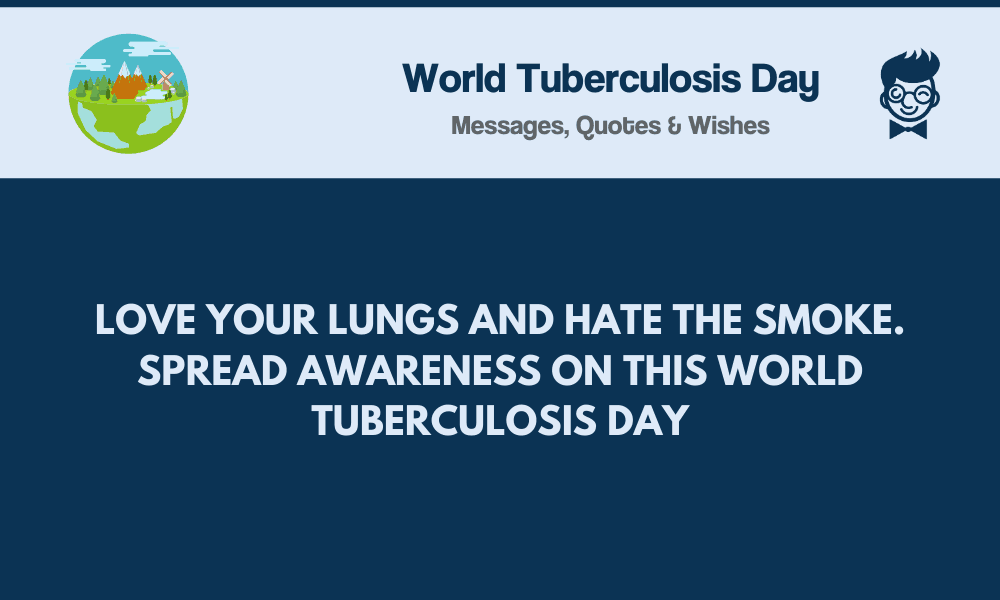 |
| Photo: TheBrandBoy |
1. Diseases take away our loved ones and hence let’s take an oath to remove this disease from everyone else.
2. Separation is a pain but separation with TB is a dream that not all can live
3. The right treatment at the right time is a dream for many and we need to turn it into reality.
4. If we shake hands with healthy living, nothing can stop us from kicking away diseases like Tuberculosis.
5. Every person wants to live healthy and the key to being healthy is to live a life that is free from any unhealthy habits.
6. Tuberculosis is a threat to existence but we can join hands and kick it right off the block!
7. Humans are intelligent and let us act smart to ensure that the world is free from diseases such as tuberculosis.
8. The shyness in people about diseases is what makes these diseases even more powerful. Let’s open up about Tuberculosis and try to educate people.
9. World Tuberculosis day asks every person to come together and reduce the possibilities of this deadly disease.
10. Is TB worth a fight? Yes it is, only if you trust and believe!
11. Find TB and cure TB. Being safe is always better than being sorry.
12. It is only us who can take the onus of our lives in our hands. Let’s not take diseases easy, we need to beat them hard.
13. We cannot be ever pulled down by the harshest disease. All we need is determination to fight it off with grit.
14. Early detection and treatment can cure the biggest of diseases without any fuss.
15. Get rid of your smoking habits, your family needs your presence more than anything else.
16. Life with TB is painful but the good news is that we can get rid of the disease!
17. Nothing can stop us if we have the determination to go the distance and live healthy.
18. Our lives are controlled by us and hence the diseases we have are reflective of the habits that we hold in our lives.
19. Love your lungs and hate the smoke. Spread awareness on this world tuberculosis day.
20. Happiness is being able to breathe the air that is healthy.
***READ MORE: Good Friday (April 2): Date, History, Significance, Facts
 Holi Festival in India: Date, Significance, Celebrations and More Holi Festival in India: Date, Significance, Celebrations and More Holi Festival is a fun festival that is celebrated in India and all over the world each spring, with a riot of colors, powder dyes ... |
 World Poetry Day (March 21): Date, History, Significance & How to celebrate World Poetry Day (March 21): Date, History, Significance & How to celebrate Poetry can change the way people view the world and inspire our flow of ideas. If you're a poetry lover, don't forget the World Poetry ... |
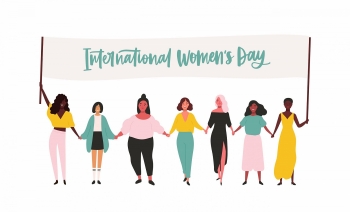 Women’s Day (March 8): History, Significance, Celebrations Women’s Day (March 8): History, Significance, Celebrations March is coming with a brilliant day to honor women - a beautiful half of the world. International Women’s Day (IWD). March 8, which will ... |


























